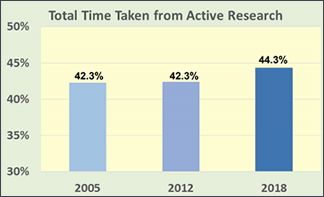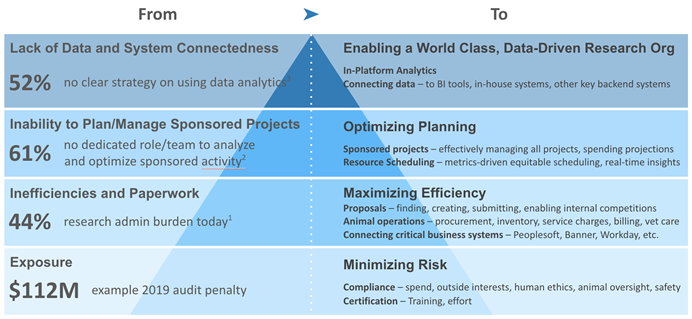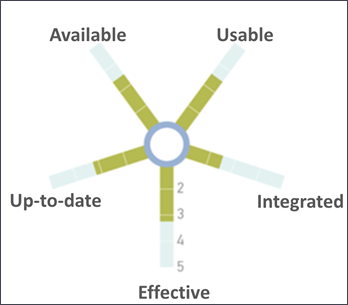
Modernizing Research - the Trends and the New Imperative
Last month, I had the pleasure of speaking at the SRAI Virtual Meeting. It was my first experience taking part in a fully virtual industry event and I’m so glad that SRAI quickly adapted to host the event together. Thank you to everyone involved in putting on a great virtual experience!
My session focused on the trends which have accelerated over the last decade around research administration systems and what the future of research administration technology holds. As the COVID-19 crisis has unfolded over the past few months, many of the trends discussed will likely further accelerate, so I wanted to share some of these industry and technology trends I covered, some of which were first reported on in the recently published LISTedTECH Grant Management in the Educational Sector report with all SRAI Catalyst readers.
 Before highlighting some of the technology trends, I think it’s important to recognize key industry trends that are ultimately serving as the catalyst for this progression. First, risk management has only become more complex, and foreign influence, along with conflicts of commitment and interest have received numerous many eye-popping headlines over the past year alone. With significant potential penalties, not only has managing compliance risks become increasingly difficult, but the stakes are also higher. This complexity has also increased the administrative burden, with over 44% of research time now spent on paperwork (2018 FDP Faculty Workload Survey).
Before highlighting some of the technology trends, I think it’s important to recognize key industry trends that are ultimately serving as the catalyst for this progression. First, risk management has only become more complex, and foreign influence, along with conflicts of commitment and interest have received numerous many eye-popping headlines over the past year alone. With significant potential penalties, not only has managing compliance risks become increasingly difficult, but the stakes are also higher. This complexity has also increased the administrative burden, with over 44% of research time now spent on paperwork (2018 FDP Faculty Workload Survey).
 As both complexity and administrative burden have increased, organizations have recognized the need to modernize and integrate systems supporting research with cloud-based solutions that are capable of supporting data and workflow integration over the past decade as was noted in the LISTedTech report.
As both complexity and administrative burden have increased, organizations have recognized the need to modernize and integrate systems supporting research with cloud-based solutions that are capable of supporting data and workflow integration over the past decade as was noted in the LISTedTech report.
All of these trends were true prior to March 2020, but now we’re in a world where process change is crucial. Additionally, we’re living in a world where virtual collaboration, managing data, uptime and system integrations are essential, and IT teams were overloaded trying to ensure organizations can even meet and function virtually.
In other words, there’s a massive From > To shift which was occurring but has now significantly accelerated to adjust to the new normal. To me, this shift is similar to Maslow’s hierarchy of needs, so let’s call it the Research Administrators hierarchy of needs. And just as the foundational level of Maslow’s hierarchy is food and shelter, for research administrators it’s about managing risk. You can draw parallels all the way up to the top of the pyramid, but the key takeaway is that research administrators are now needing modernized processes and systems that help them address all these needs holistically.

Data: 1 2018 FDP Faculty Workload Study 2 SRA published research 12/11/19 3 SRA published research 2/13/20
 To support moving up the hierarchy, research administrators need systems that are highly:
To support moving up the hierarchy, research administrators need systems that are highly:
Available: Any time, anywhere
Usable: Minimal training required
Up-to-date: Ahead of regulations
Integrated: Eliminate duplicate data entry
Effective: Gain real efficiency leveraging modern technology
Organizations should be actively assessing their current systems and processes, possibly with a rubric in mind that maps to these areas, with rating yourself across these areas -
Some examples of the questions you might consider asking yourself about your current systems include:
On a scale of 1 to 5...
- Ease in updating tech to match updates to your processes
- Ease of upgrading your system(s) ahead of regulation change
- Level of reliance on IT for updates compared to availability/bandwidth
How many systems are used?
How often does your current system(s) get updated/upgraded? (monthly, quarterly, annually, etc.)
You might also want to think of auditing your processes and systems in terms of those hierarchy of needs and how well those systems are connected and helping drive impact in all of those areas:
For example, in your institution, on a scale of 1 to 5, how effective do you feel are your systems in helping us solve each challenge area within the hierarchy of challenges?
- Managing data
- Optimizing planning
- Maximizing efficiency
- Minimizing risk
There’s never been a better, or more important, time to be asking these questions as well as considering putting your institution through some level of audit. I hope this article helps you with taking action and improving your systems and processes to support a world that looks to have forever changed in how great research administration gets done.

Authored by Matt McLellan, CEO
Cayuse
#Catalyst#May2020#insights#COVID#trends#Cayuse#Featured